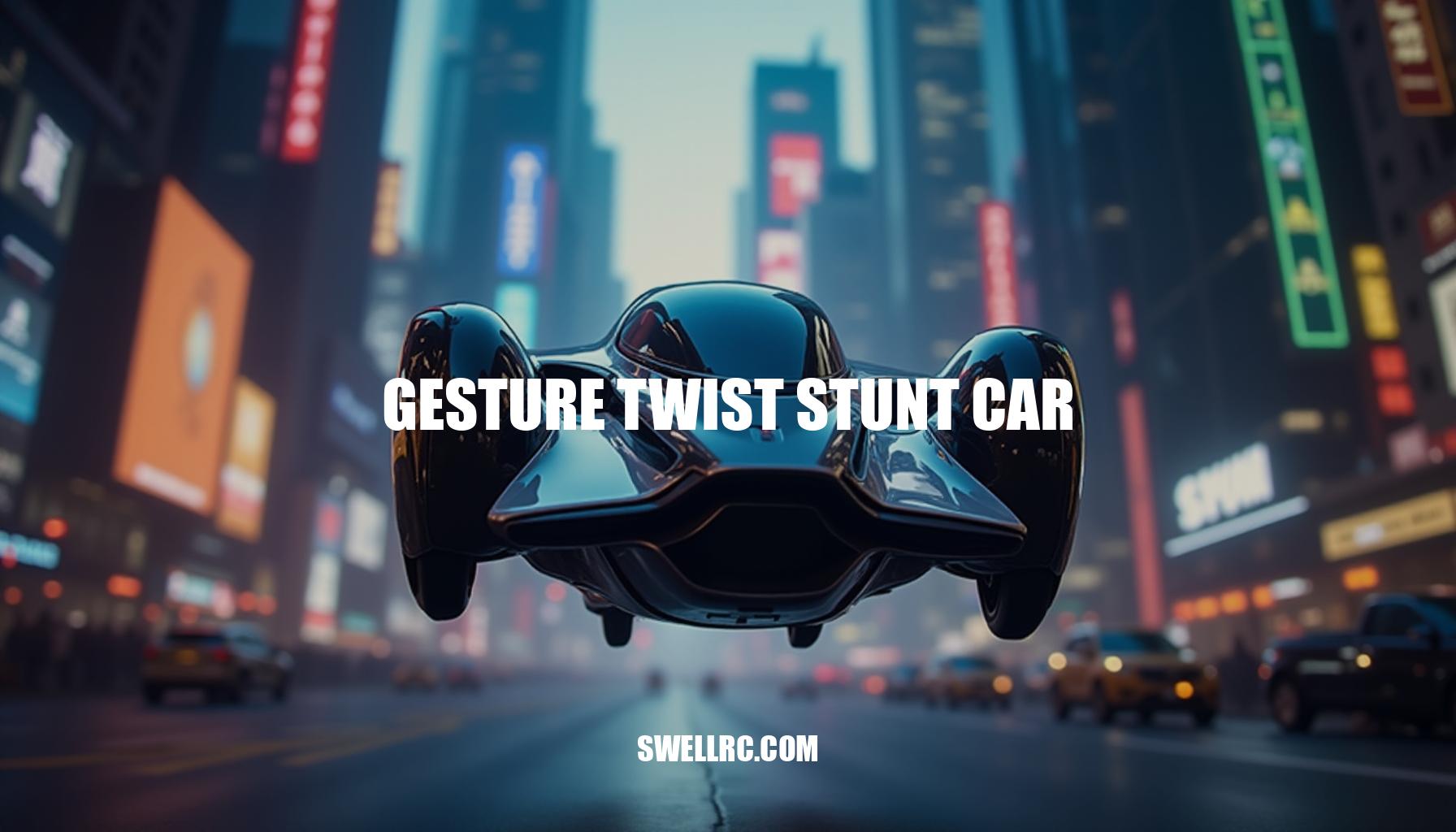Unlocking the Future of RC with Gesture Twist Stunt Cars
I still remember the first time a gesture twist stunt car skittered across my living room floor, pirouetting the moment I tilted my wrist. It felt less like driving a remote control car and more like conducting a symphony—tech, motion, and a little artistry all in sync. I’d grown up with traditional transmitters, but the leap to hand gesture control toys made everything feel instantly intuitive, almost telepathic.
Innovations like hand gesture control cars and wearable, wrist-based controllers paved the way; the twist chassis and double-sided drive took it even further. The smart RC technology embedded in these RC stunt cars allows for smoother, more dynamic movements, making each stunt a precise ballet of speed and agility. The RC car with wrist remote feature eliminates the learning curve of traditional controllers, letting users focus purely on the thrill of the ride.
So, what exactly makes a gesture twist stunt car so revolutionary—and how does it outperform the RC I thought I knew? Let’s dive into the tech, the stunts, and the real-world thrills that set it apart.
The Magic Behind Gesture Control – How It Actually Works
Under the shell, a modern gesture-controlled RC car employs smart RC technology featuring a compact IMU—a blend of accelerometers and gyroscopic sensors—that translates wrist motion into precise commands. Think of it as a wearable instrument that reads tilt, roll, and flick patterns, then maps them to steering, twisting, and speed modes through advanced gesture mapping. This system incorporates a gyro balance system to smooth out jitter, ensuring the car tracks cleanly, much like the stability benefits observed with dedicated gyro modules (see here).
A quick calibration—holding your wrist neutral while the system zeros out—teaches the car your ‘center,’ making control feel natural within minutes.
Compared with classic hand-control remote cars (learn more), this innovative gesture input shortens the learning curve: your hand effectively becomes the joystick, offering more intuitive controls. Here’s how that mind-hand sync translates on the ground using gesture mapping:
| Gesture | Command | Motion Outcome |
|---|---|---|
| Tilt wrist left | Yaw left | Smooth lateral steering or crab-walk (depending on mode) |
| Tilt wrist right | Yaw right | Mirrored lateral steering |
| Rotate wrist clockwise | Spin command | 360-degree rotate or tight donut |
| Quick palm flick forward | Throttle burst | Sprint start over short distance |
| Palm down press | Low-profile mode | Chassis lowers for speed and stability |
| Palm up cue | High-clearance mode | Twist chassis rises to clear obstacles |
| Double-tap gesture | Trick macro | 180 flip using double-sided drive |
Twist, Flip, and Conquer: The Stunt Capabilities That Set It Apart
The twist chassis is the secret sauce behind advanced 4×4 stunt cars. By articulating the center frame, a twist stunt vehicle can hunker down for speed runs or rise to tackle obstacles—paired with a 4×4 drive system and independent wheel modules that excel on mixed terrain. This off-road twisting design provides unparalleled surface adaptation, allowing the vehicle to perform flawless stunts in varied environments.
Featuring double-sided drive, a botched flip simply turns into part of the routine as the car lands on the ‘roof’ and keeps going. This fearless approach to rotation control and recovery was pioneered by classics like the Tyco Rebound 4×4 and continues to influence modern stunt platforms.
When compared to traditional RC cars, the benefits of gesture twist stunt cars become clear:
- Surface adaptation: Basic suspensions versus the advanced off-road twisting design and height change capabilities that tackle diverse terrains.
- Rotation control: Simple trigger spins compared to nuanced wrist-rolled 360s and instant pivots allowing for precise maneuverability.
- Flip recovery: Manual resets versus automatic recovery through double-sided drive mechanisms.
- Drift response: On/off throttle control compared to feathered slides triggered by subtle wrist cues for refined drifting.
- Obstacle handling: Bump-and-stop reactions opposed by twist-and-climb techniques enabled by raised clearance and chassis articulation.
Durability is critical when executing flips and high-speed stunts. Top contenders in the best RC stunt car category utilize reinforced linkages, flexible tires, and shock-absorbing shells to withstand intense action. For those seeking novelty, some models even experiment with vertical surfaces and suction dynamics, reminiscent of the groundbreaking anti-gravity remote control car experiments.
Performance Meets Play: Real-World Testing and Impressions
I ran timing passes and stunt drills across three surfaces to see how the car’s gesture control drift car mapping held up under pressure. After an afternoon of spins, flips, and emergency recoveries, the control felt second nature—like pointing exactly where I wanted momentum to go, showcasing impressive maneuverability rarely found in a remote control drift car.
Here’s a test summary based on a representative sample with a mid-range rechargeable stunt car:
| Surface | Top Speed (km/h) | Control Precision | Drift Characteristics |
|---|---|---|---|
| Indoor Hardwood | 12–14 | High | Clean drift lines with minimal tire squeal |
| Asphalt | 14–16 | Medium-High | Broad, predictable arcs in drift lines |
| Short Grass | 9–11 | Medium | Limited drift lines relying on torque and higher clearance |
When engaging in drift-specific play, remember that tire compound and throttle ramping can affect performance as much as gestures. It helps to study how purpose-built remote control drift cars manage traction balance. Similarly, the aggressive style cues popularized by Hoonigan RC drift car builds provide a valuable reference point for tuning expectations.
On the battery front, a few tips that enhance battery life and overall session quality include fully cycling the pack twice before extended runs, letting the ESC cool between packs, and keeping the tires clean to preserve runtime. After endless spins and flips, I finally understood why these gesture-controlled devices feel addictive: every wrist cue becomes a tiny celebration when the chassis responds instantly with precision and confidence.
For Whom Are Gesture Twist Stunt Cars Perfect?
When choosing children’s RC vehicles, it is important to consider several factors that cater to different user groups while emphasizing durability, ease of use, and safety. For kids and families, look for models with rugged shells, enclosed gears, and safe speed profiles. Features like gyro-stabilized control help beginners maintain a straight line, and double-sided drive reduces frustration during play.
- Kids and families: Rugged shells, enclosed gears, safe speed profiles, gyro-stabilized control, and double-sided drive enhance safety and ease of use.
- RC hobbyists: Focus on skill expression, including chaining flips, linking drifts, and adjusting ride height dynamically. The strong mod potential allows for upgrades in tires, gearing, and batteries.
- Collectors and tech lovers: Innovative features like gesture control and twist chassis exemplify smart RC technology and evolving form factors, making these models standout conversation pieces.
- Educators and STEM clubs: Ideal for demonstrating sensors, IMUs, and control loops, providing instant feedback that students can both see and feel.
If you’re already exploring the higher end of the category, it’s beneficial to cross-reference specs and tuning ideas from professional RC cars. This comparison helps to understand how stunt-focused builds prioritize robustness over race-grade precision. For younger drivers, prioritizing durability, ease of use, and parental guidance is essential until gesture controls become second nature.
Conclusion: Why Gesture Twist Stunt Cars Are the Future of Fun Mobility
Gesture twist stunt cars epitomize the future of RC with their seamless blend of sensor-driven play, innovation, and precision control. Powered by IMU technology, these cars deliver an interactive RC experience that responds naturally to your movements, making them feel like an extension of your body rather than just a device in your hands. The twist chassis design ensures continuous action across various surfaces, while the double-sided drive transforms crashes into a dynamic form of choreography.
My personal journey with these vehicles began with simple curiosity and evolved into a deep appreciation for sensor-driven design.
This experience encouraged me to explore adjacent niches, such as:
- Hand gesture controlled cars
- Wrist-wearable controllers
- Anti-gravity mobility concepts
Each innovation pushes the boundaries of engaging mobility, redefining how we interact with remote-controlled devices. If you’re ready to elevate your RC experience with unmatched precision and effortless control, gesture twist stunt cars represent a transformative leap into the future of RC.
Frequently Asked Questions
- What is a gesture twist stunt car and how does it differ from other RC cars?
It’s a 4×4 stunt-focused RC with a twistable chassis and double-sided drive that you control via wrist or hand gestures. Unlike standard transmitter setups, an onboard IMU (accelerometers plus gyros) converts wrist tilt and rotation into steering, throttle, and stunt macros—making flips, spins, and obstacle climbs easier and more intuitive. - How does gesture control technology work in RC stunt cars?
A wearable controller reads motion through an IMU, filters noise, and maps recognized gestures to commands. After a brief calibration to set a neutral position, the car executes steering, throttle, twist-height changes, or preset stunts with low-latency responses. Gyro-assisted logic smooths inputs for stable, predictable handling. - Can a gesture twist stunt car perform flips and drifts on any surface?
It can flip and drift on many surfaces, but results depend on traction and clearance. Smooth floors and asphalt favor controlled spins and drifts; short grass requires torque and raised clearance; thick carpet or loose gravel may limit clean slides. Suction-based or “anti-gravity” play requires purpose-built designs, not standard stunt tires. - Are gesture twist stunt cars durable enough for kids?
Most are designed with impact-absorbing shells, flexible tires, and enclosed drivetrains. For younger drivers, choose models with reinforced arms, moderate speeds, and good after-sales support. Supervision is wise until kids master gesture sensitivity and understand safe operating spaces. - What are the top brands or models for gesture-controlled stunt cars?
Look for models that combine IMU-based gesture input, twistable chassis, double-sided drive, and strong parts support. Check community-tested lists and durability reviews, and prioritize ABS shells, metal linkages in stress points, and easily replaceable tires and batteries.



